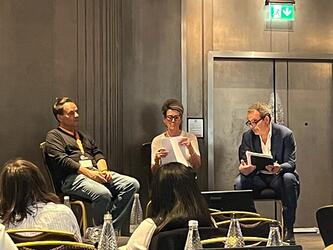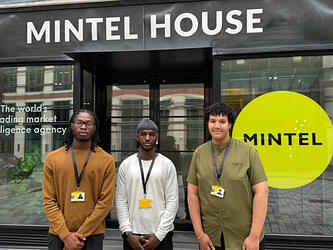Decoding the brain’s love for stories: why narrative still matters in a fragmented world

We are wired for stories. We crave them, dream them, build them and consume them. Stories are the lifeblood of human experience. But why are they so effective? And how can we better harness their power in a world of fragmented attention and evolving narratives?
As marketers, it’s down to us to capture the right formula but what is that? Should we go back to the basics in a ‘content overload’ landscape?
The dual processing power of stories
The effectiveness of storytelling lies in its ability to engage both our cognitive and emotional processes. It’s not just about feeling good; it’s about how our brains are structured to process information. Stories activate multiple brain regions, boosting neural activity and strengthening the formation of memories. When we listen to a story, we're not just passively receiving information; we're actively reconstructing it, imagining scenes, feeling emotions and relating them to ourselves.
For example, think about John Lewis’ meticulously crafted Christmas ads, each a mini-movie tugging at our heartstrings, versus current Jaguar, KFC or Nike’s type of communication – sometimes abstract, unstructured campaigns. Both approaches have their own magic – one provides comforting embrace, while the other challenges us, energises us, and makes us rethink our perspectives.
This dual activation of emotion and cognition is the key to understanding storytelling’s persuasive power. A compelling narrative can bypass our rational defences, making us less likely to resist its message. Stories can also trigger the release of oxytocin, a neurochemical that enhances connection, empathy and emotional engagement.
Therefore, effective stories don't just entertain; they make us think and feel. This dual processing is crucial for understanding how stories influence our beliefs and behaviours. For organisations and marketers, understanding this interplay is essential for crafting impactful narratives.
Creativity doesn’t come with a recipe book, but there are some ingredients that always elevate the dish. Storytelling is one such secret sauce. But here’s the million-dollar question: does a linear, well-defined narrative always outperform its unstructured, more ambiguous cousin?
Can we captivate audiences without a clear storyline, and can we evoke deep emotional connections through seemingly chaotic narratives or an absence of narrative?
Navigating the narrative landscape: linear vs. chaotic
Traditionally, linear storytelling, with its clear beginning, middle, and end, has been considered the gold standard. This structure provides clarity, control and a sense of order, making it easy for audiences to follow and understand.
However, the digital age has ushered in an era of fragmented attention and non-linear experiences. Modern narratives are often disjointed, spread across platforms, and presented in interactive formats. This shift reflects the chaotic nature of our current media environment.
While linear narratives still hold value, particularly for conveying complex information and fostering understanding, fragmented storytelling offers unique advantages – it can capture attention in a fast-paced world, spark curiosity and encourage active audience participation.
By presenting information in a non-linear fashion, storytellers invite audiences to become active sense-makers, filling in the gaps and constructing meaning from fragments. This active participation can lead to deeper engagement and emotional resonance.
Audiences are no longer passive recipients of stories; they are active participants in the sense-making process. This shift challenges traditional communication models and requires a deeper understanding of how audiences connect the dots and create meaning from fragmented narratives.
Research implications and future directions
These two takeaways have significant implications for research and practice. Traditional research models, often based on outdated persuasion theories, may not adequately capture the complexity of modern storytelling. We need new tools and methodologies to understand how people process both linear and non-linear narratives, particularly in the context of fragmented media environments.
Neuroscience and behavioural science offer promising avenues for exploring the dual processing power of stories and the role of audience sense-making. Theories like social cognitive theory and exemplification theory, along with tools like the Narrative Engagement Scale, can provide valuable insights into how audiences connect with stories and how those connections influence their attitudes and behaviours.
Furthermore, we need to move beyond simple message recall as a measure of effectiveness. Effective storytelling can influence brand equity even if the message isn't consciously remembered. We need more holistic research approaches that consider the multidimensional impact of stories on our thoughts, feelings, and behaviours.
Finally, we need to help marketers and creatives leverage these insights to amplify emotional and cognitive engagement on new communication platforms and brand experiences. By bridging the gap between academic research and practical application, we can unlock the full potential of storytelling in the digital age. This requires not only understanding the science of storytelling but also embracing the art of crafting compelling narratives that resonate with audiences on a deeper level.
Cristina de Balanzo is director and head of brand and comms at Walnut Unlimited, part of Accenture Song

We hope you enjoyed this article.
Research Live is published by MRS.
The Market Research Society (MRS) exists to promote and protect the research sector, showcasing how research delivers impact for businesses and government.
Members of MRS enjoy many benefits including tailoured policy guidance, discounts on training and conferences, and access to member-only content.
For example, there's an archive of winning case studies from over a decade of MRS Awards.
Find out more about the benefits of joining MRS here.














0 Comments